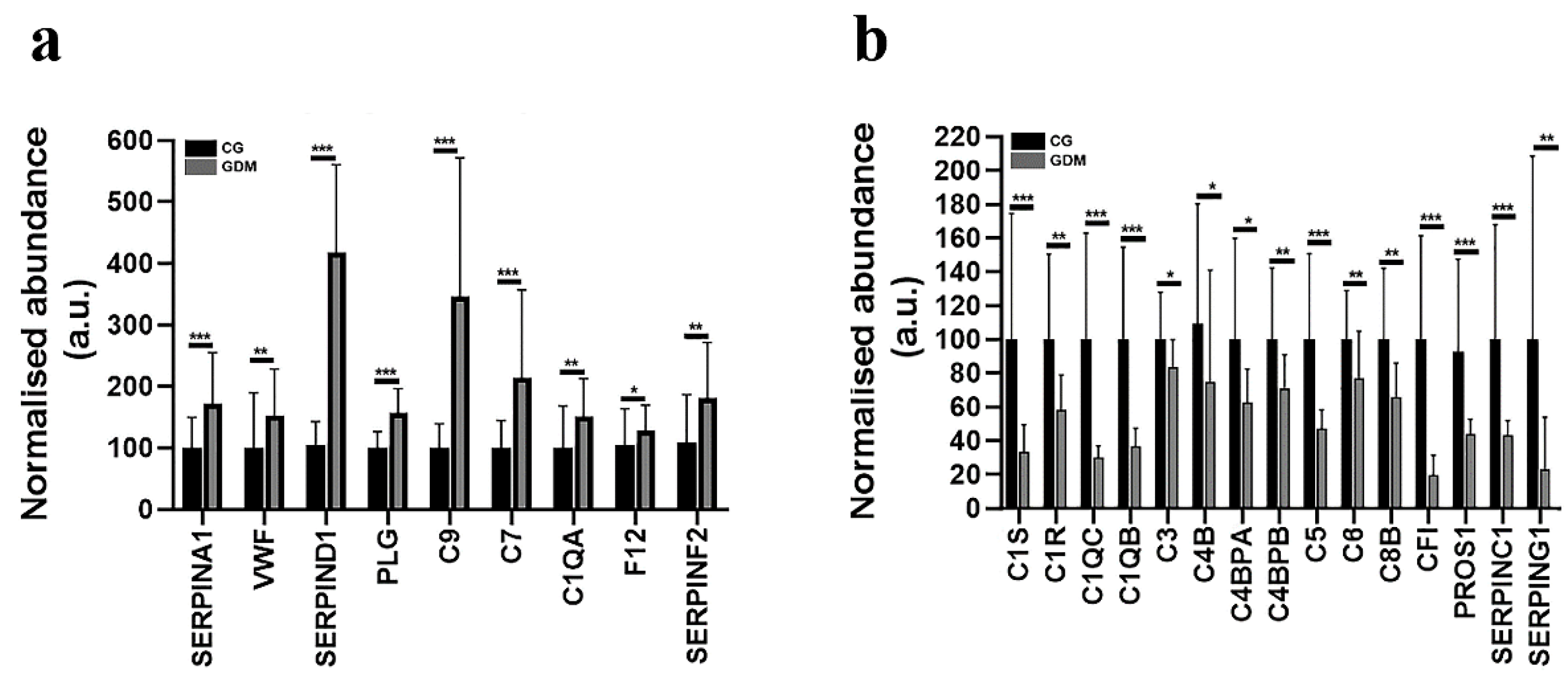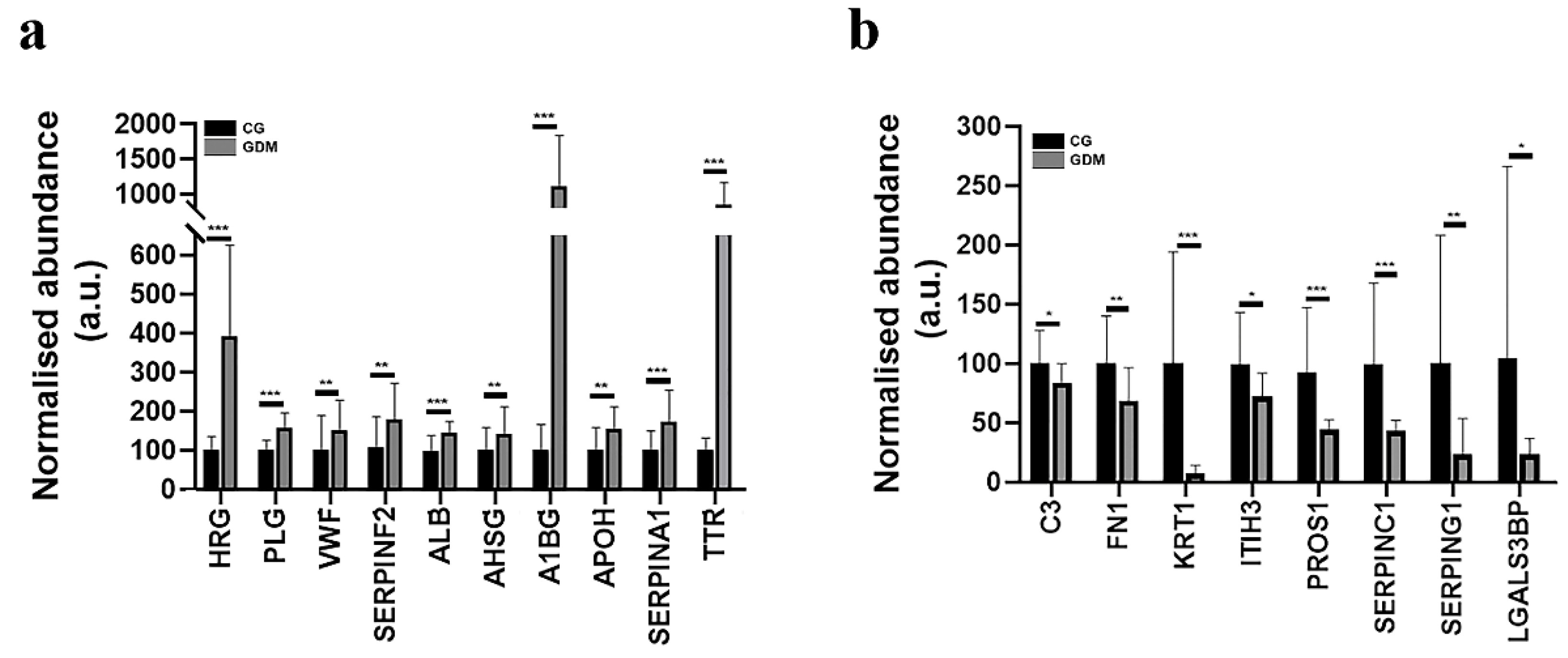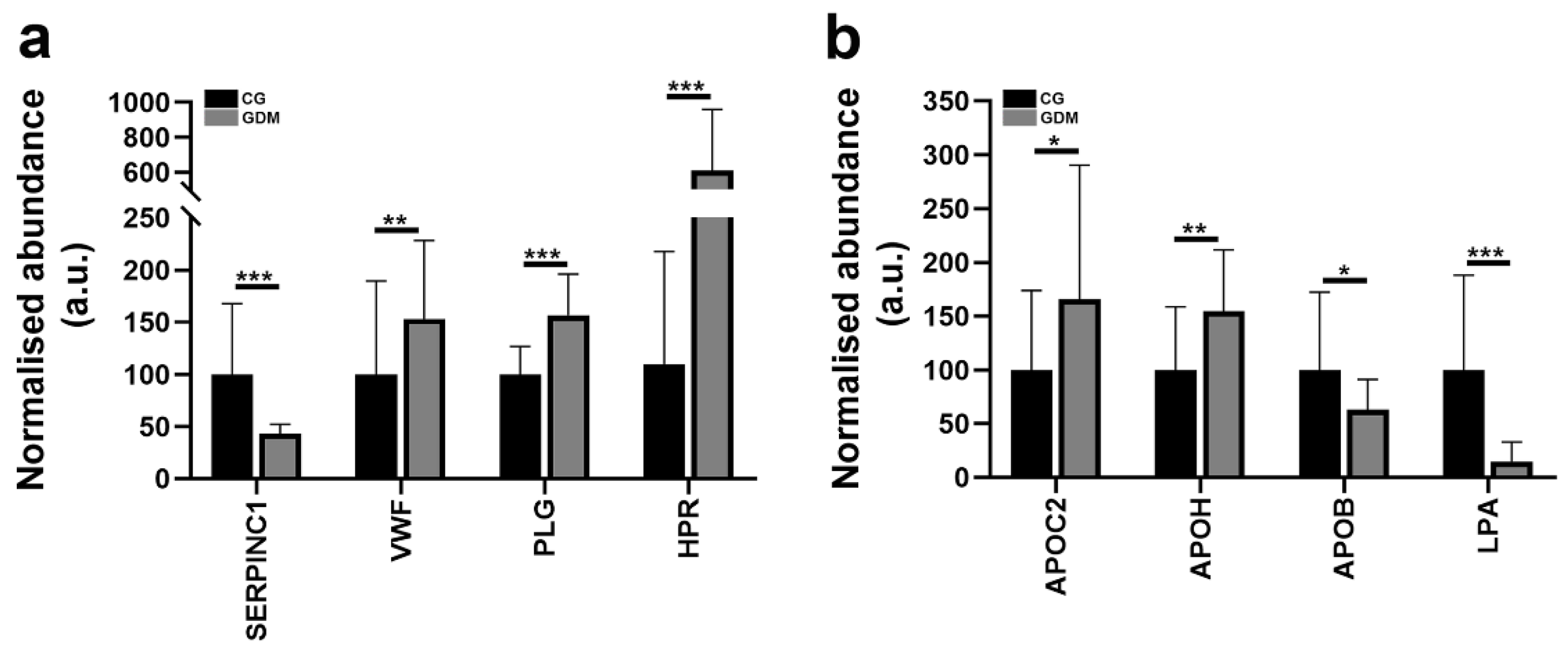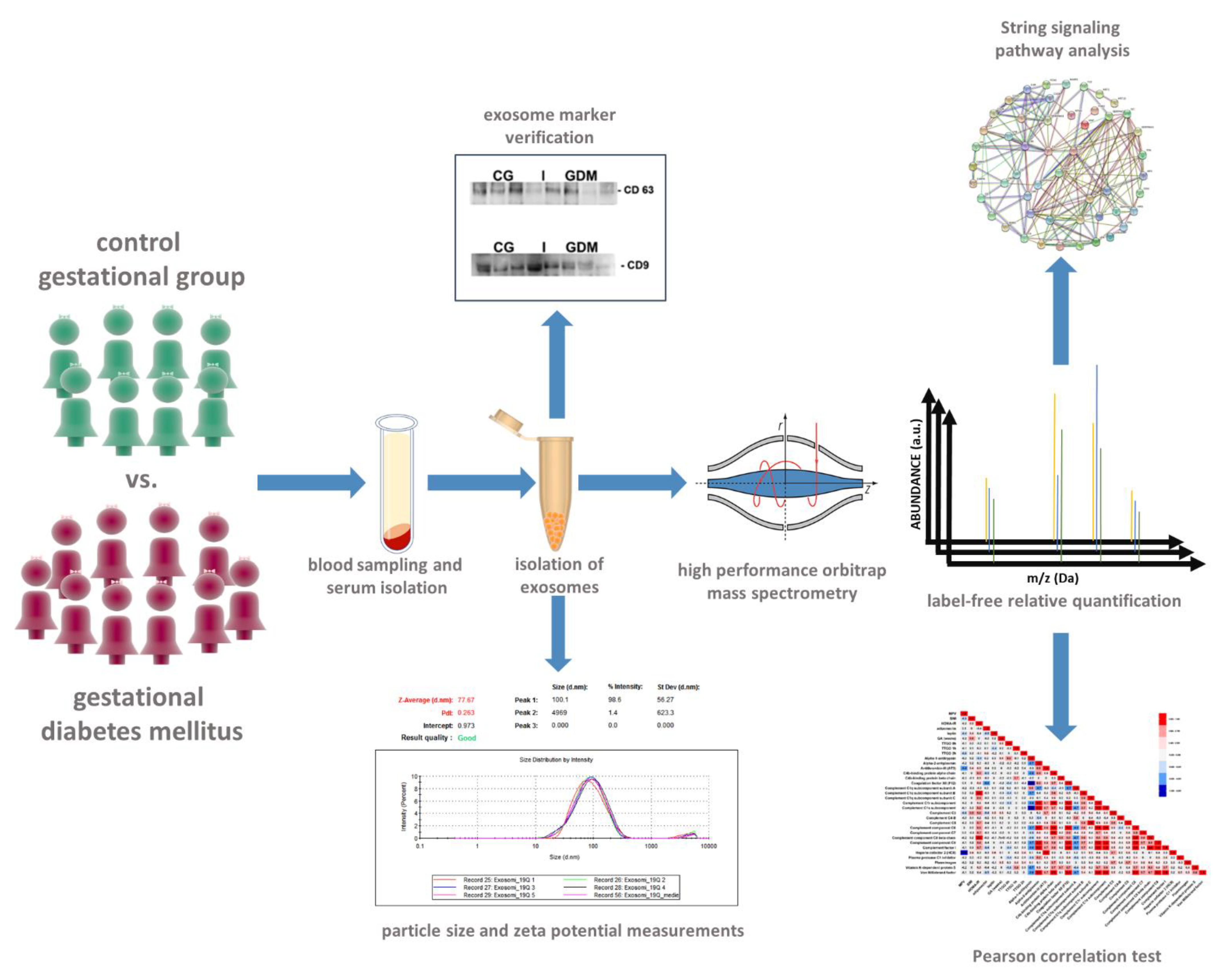Exosome Proteomics Reveals the Deregulation of Coagulation, Complement and Lipid Metabolism Proteins in Gestational Diabetes Mellitus
Abstract
1. Introduction
2. Results
2.1. Characteristics of the Study Cohort
2.2. Characterization of Serum Exosome Fractions
2.3. Exosome Proteome Analysis
2.4. Differentially Abundant Proteins Involved in the Complement and Coagulation Cascade
2.5. Differentially Abundant Proteins Involved in Platelet Degranulation
2.6. Gestational Diabetes Regulates Proteins Involved in the Post-Thrombotic Syndrome and Cholesterol Metabolism
2.7. Alternative Validation Studies
2.8. Statistical Correlations between Serum Clinical Parameters and Dysregulated Proteins
3. Discussion
4. Materials and Methods
4.1. Study Subjects
4.2. Sociodemographic Data
4.3. Blood Sampling, Serum Parameters Measurement and Exosome Concentration and Characterisation
4.4. Sample Preparation and Nano Liquid Chromatography—Mass Spectrometry Analysis
4.5. Western Blot Analysis
4.6. Statistical Analysis
5. Conclusions
- Gestational diabetes regulates exosomal protein abundance associated with the complement and coagulation cascade;
- Proteins involved in the thrombotic mechanism and cholesterol metabolism are differentially altered by the pathological state;
- Statistical correlations have been obtained between the clinical and paraclinical parameters and the exosome proteome that could improve the understanding of gestational diabetes mellitus pathogenesis and evolution.
Supplementary Materials
Author Contributions
Funding
Institutional Review Board Statement
Informed Consent Statement
Data Availability Statement
Conflicts of Interest
References
- Cho, N.H.; Shaw, J.E.; Karuranga, S.; Huang, Y.; da Rocha Fernandes, J.D.; Ohlrogge, A.W.; Malanda, B. IDF Diabetes Atlas: Global Estimates of Diabetes Prevalence for 2017 and Projections for 2045. Diabetes Res. Clin. Pract. 2018, 138, 271–281. [Google Scholar] [CrossRef] [PubMed]
- American Diabetes Association Professional Practice Committee Management of Diabetes in Pregnancy: Standards of Medical Care in Diabetes—2022. Diabetes Care 2022, 45, S232–S243. [CrossRef] [PubMed]
- Czernek, L.; Düchler, M. Exosomes as Messengers Between Mother and Fetus in Pregnancy. Int. J. Mol. Sci. 2020, 21, 4264. [Google Scholar] [CrossRef] [PubMed]
- Alzahrani, F.A.; Shait Mohammed, M.R.; Alkarim, S.; Azhar, E.I.; El-Magd, M.A.; Hawsawi, Y.; Abdulaal, W.H.; Yusuf, A.; Alhatmi, A.; Albiheyri, R. Untargeted Metabolic Profiling of Extracellular Vesicles of SARS-CoV-2-Infected Patients Shows Presence of Potent Anti-Inflammatory Metabolites. Int. J. Mol. Sci. 2021, 22, 10467. [Google Scholar] [CrossRef]
- Peng, L.; Chen, Y.; Shi, S.; Wen, H. Stem cell-derived and circulating exosomal microRNAs as new potential tools for diabetic nephropathy management. Stem Cell Res. Ther. 2022, 13, 25. [Google Scholar] [CrossRef]
- Yang, X.; Wu, N. MicroRNAs and Exosomal microRNAs May Be Possible Targets to Investigate in Gestational Diabetes Mellitus. Diabetes Metab. Syndr. Obes. 2022, 15, 321–330. [Google Scholar] [CrossRef]
- Cifani, P.; Kentsis, A. Towards Comprehensive and Quantitative Proteomics for Diagnosis and Therapy of Human Disease. Proteomics 2017, 17, 108–117. [Google Scholar] [CrossRef]
- Mavreli, D.; Evangelinakis, N.; Papantoniou, N.; Kolialexi, A. Quantitative Comparative Proteomics Reveals Candidate Biomarkers for the Early Prediction of Gestational Diabetes Mellitus: A Preliminary Study. In Vivo 2020, 34, 517–525. [Google Scholar] [CrossRef]
- Kim, J.A.; Kim, J.E.; Song, S.H.; Kim, H.K. Influence of Blood Lipids on Global Coagulation Test Results. Ann. Lab. Med. 2015, 35, 15–21. [Google Scholar]
- Teliga-Czajkowska, J.; Sienko, J.; Zareba-Szczudlik, J.; Malinowska-Polubiec, A.; Romejko-Wolniewicz, E.; Czajkowski, K. Influence of Glycemic Control on Coagulation and Lipid Metabolism in Pregnancies Complicated by Pregestational and Gestational Diabetes Mellitus. Adv. Exp. Med. Biol. 2019, 1176, 81–88. [Google Scholar]
- Ozbasli, E.; Takmaz, O.; Karabuk, E.; Gungor, M. Comparison of Factor XII Levels in Gestational Diabetes, Fetal Macrosomia, and Healthy Pregnancies. BMC Pregnancy Childbirth 2020, 20, 752. [Google Scholar] [CrossRef] [PubMed]
- Sahbaz, A.; Cicekler, H.; Aynioglu, O.; Isik, H.; Ozmen, U. Comparison of the Predictive Value of Plateletcrit with Various Other Blood Parameters in Gestational Diabetes Development. J. Obstet. Gynaecol. 2016, 36, 589–593. [Google Scholar] [CrossRef] [PubMed]
- Iyidir, O.T.; Degertekin, C.K.; Yilmaz, B.A.; Toruner, F.B.; Akturk, M.; Arslan, M. Elevated Mean Platelet Volume Is Associated with Gestational Diabetes Mellitus. Gynecol. Endocrinol. 2014, 30, 640–643. [Google Scholar] [CrossRef]
- Çeltik, A.; Akıncı, B.; Demir, T. Mean Platelet Volume in Women with Gestational Diabetes. Turkish J. Endocrinol. Metab. 2016, 20, 48–53. [Google Scholar] [CrossRef]
- Gorar, S.; Abanonu, G.B.; Uysal, A.; Erol, O.; Unal, A.; Uyar, S.; Cekin, A.H. Comparison of Thyroid Function Tests and Blood Count in Pregnant Women with versus without Gestational Diabetes Mellitus. J. Obstet. Gynaecol. Res. 2017, 43, 848–854. [Google Scholar] [CrossRef] [PubMed]
- Maluf, C.B.; Barreto, S.M.; Dos Reis, R.C.P.; Vidigal, P.G. Platelet Volume Is Associated with the Framingham Risk Score for Cardiovascular Disease in the Brazilian Longitudinal Study of Adult Health (ELSA-Brasil). Clin. Chem. Lab. Med. 2016, 54, 879–887. [Google Scholar] [CrossRef]
- Cunnane, E.M.; Weinbaum, J.S.; O’Brien, F.J.; Vorp, D.A. Future Perspectives on the Role of Stem Cells and Extracellular Vesicles in Vascular Tissue Regeneration. Front. Cardiovasc. Med. 2018, 5, 86. [Google Scholar] [CrossRef]
- Willms, E.; Cabañas, C.; Mäger, I.; Wood, M.J.A.; Vader, P. Extracellular Vesicle Heterogeneity: Subpopulations, Isolation Techniques, and Diverse Functions in Cancer Progression. Front. Immunol. 2018, 9, 738. [Google Scholar] [CrossRef]
- Jayabalan, N.; Lai, A.; Nair, S.; Guanzon, D.; Scholz-Romero, K.; Palma, C.; McIntyre, H.D.; Lappas, M.; Salomon, C. Quantitative Proteomics by SWATH-MS Suggest an Association Between Circulating Exosomes and Maternal Metabolic Changes in Gestational Diabetes Mellitus. Proteomics 2019, 19, e1800164. [Google Scholar] [CrossRef]
- Ramanjaneya, M.; Butler, A.E.; Alkasem, M.; Bashir, M.; Jerobin, J.; Godwin, A.; Moin, A.S.M.; Ahmed, L.; Elrayess, M.A.; Hunt, S.C.; et al. Association of Complement-Related Proteins in Subjects with and Without Second Trimester Gestational Diabetes. Front. Endocrinol. 2021, 12, 641361. [Google Scholar] [CrossRef]
- Richani, K.; Soto, E.; Romero, R.; Espinoza, J.; Chaiworapongsa, T.; Nien, J.K.; Edwin, S.; Kim, Y.M.; Hong, J.S.; Mazor, M. Normal Pregnancy Is Characterized by Systemic Activation of the Complement System. J. Matern. Fetal. Neonatal Med. 2005, 17, 239–245. [Google Scholar] [CrossRef] [PubMed]
- Copenhaver, M.; Yu, C.-Y.; Hoffman, R.P. Complement Components, C3 and C4, and the Metabolic Syndrome. Curr. Diabetes Rev. 2019, 15, 44–48. [Google Scholar] [CrossRef] [PubMed]
- Ghosh, P.; Sahoo, R.; Vaidya, A.; Chorev, M.; Halperin, J.A. Role of Complement and Complement Regulatory Proteins in the Complications of Diabetes. Endocr. Rev. 2015, 36, 272–288. [Google Scholar] [CrossRef] [PubMed]
- Kennelly, M.A.; Killeen, S.L.; Phillips, C.M.; Alberdi, G.; Lindsay, K.L.; Mehegan, J.; Cronin, M.; McAuliffe, F.M. Maternal C3 Complement and C-Reactive Protein and Pregnancy and Fetal Outcomes: A Secondary Analysis of the PEARS RCT-An MHealth-Supported, Lifestyle Intervention among Pregnant Women with Overweight and Obesity. Cytokine 2022, 149, 155748. [Google Scholar] [CrossRef]
- Onat, A.; Hergenç, G.; Can, G.; Kaya, Z.; Yüksel, H. Serum Complement C3: A Determinant of Cardiometabolic Risk, Additive to the Metabolic Syndrome, in Middle-Aged Population. Metabolism 2010, 59, 628–634. [Google Scholar] [CrossRef]
- Engström, G.; Hedblad, B.; Eriksson, K.F.; Janzon, L.; Lindgärde, F. Complement C3 Is a Risk Factor for the Development of Diabetes: A Population-Based Cohort Study. Diabetes 2005, 54, 570–575. [Google Scholar] [CrossRef]
- Engström, G.; Hedblad, B.; Berglund, G.; Janzon, L.; Lindgärde, F. Plasma Levels of Complement C3 Is Associated with Development of Hypertension: A Longitudinal Cohort Study. J. Hum. Hypertens. 2007, 21, 276–282. [Google Scholar] [CrossRef]
- Muscari, A.; Bozzoli, C.; Puddu, G.M.; Sangiorgi, Z.; Dormi, A.; Rovinetti, C.; Descovich, G.C.; Puddu, P. Association of Serum C3 Levels with the Risk of Myocardial Infarction. Am. J. Med. 1995, 98, 357–364. [Google Scholar] [CrossRef]
- Weyer, C.; Tataranni, P.A.; Pratley, R.E. Insulin Action and Insulinemia Are Closely Related to the Fasting Complement C3, but Not Acylation Stimulating Protein Concentration. Diabetes Care 2000, 23, 779–785. [Google Scholar] [CrossRef]
- Wlazlo, N.; Van Greevenbroek, M.M.J.; Ferreira, I.; Feskens, E.J.M.; Van Der Kallen, C.J.H.; Schalkwijk, C.G.; Bravenboer, B.; Stehouwer, C.D.A. Complement Factor 3 Is Associated with Insulin Resistance and with Incident Type 2 Diabetes over a 7-Year Follow-up Period: The CODAM Study. Diabetes Care 2014, 37, 1900–1909. [Google Scholar] [CrossRef]
- Sriboonvorakul, N.; Tan, B.K.; Hu, J.; Boriboonhirunsarn, D.; Ng, L.L. Proteomics Studies in Gestational Diabetes Mellitus: A Systematic Review and Meta-Analysis. J. Clin. Med. 2022, 11, 2737. [Google Scholar] [CrossRef] [PubMed]
- O’Riordan, M.N.; Higgins, J.R. Haemostasis in Normal and Abnormal Pregnancy. Best Pract. Res. Clin. Obstet. Gynaecol. 2003, 17, 385–396. [Google Scholar] [CrossRef]
- Schmeidler-Sapiro, K.T.; Ratnoff, O.D.; Gordon, E.M. Mitogenic Effects of Coagulation Factor XII and Factor XIIa on HepG2 Cells. Proc. Natl. Acad. Sci. USA 1991, 88, 4382–4385. [Google Scholar] [CrossRef] [PubMed]
- Janciauskiene, S.M.; Bals, R.; Koczulla, R.; Vogelmeier, C.; Köhnlein, T.; Welte, T. The Discovery of A1-Antitrypsin and Its Role in Health and Disease. Respir. Med. 2011, 105, 1129–1139. [Google Scholar] [CrossRef] [PubMed]
- Ganrot, P.O.; Gydell, K.; Ekelund, H. Serum Concentration of Alpha-2-Macroglobulin, Haptoglobin and Alpha-1-Antitrypsin in Diabetes Mellitus. Acta Endocrinol. 1967, 55, 537–544. [Google Scholar] [CrossRef]
- Lisowska-Myjak, B.; Sygitowicz, G.; Wolf, B.; Pachecka, J. Serum Alpha-1-Antitrypsin Concentration during Normal and Diabetic Pregnancy. Eur. J. Obstet. Gynecol. Reprod. Biol. 2001, 99, 53–56. [Google Scholar]
- Yaghmaei, M.; Hashemi, M.; Shikhzadeh, A.; Mokhtari, M.; Niazi, A.; Ghavami, S. Serum Trypsin Inhibitory Capacity in Normal Pregnancy and Gestational Diabetes Mellitus. Diabetes Res. Clin. Pract. 2009, 84, 201–204. [Google Scholar] [CrossRef]
- Guttman, O.; Yossef, R.; Freixo-Lima, G.; Rider, P.; Porgador, A.; Lewis, E.C. A1-Antitrypsin Modifies General NK Cell Interactions with Dendritic Cells and Specific Interactions with Islet β-Cells in Favor of Protection from Autoimmune Diabetes. Immunology 2014, 144, 530–539. [Google Scholar] [CrossRef]
- Gottlieb, P.A.; Alkanani, A.K.; Michels, A.W.; Lewis, E.C.; Shapiro, L.; Dinarello, C.A.; Zipris, D. A1-Antitrypsin Therapy Downregulates Toll-like Receptor-Induced IL-1β Responses in Monocytes and Myeloid Dendritic Cells and May Improve Islet Function in Recently Diagnosed Patients with Type 1 Diabetes. J. Clin. Endocrinol. Metab. 2014, 99, E1418–E1426. [Google Scholar] [CrossRef]
- Zhang, B.; Lu, Y.; Campbell-Thompson, M.; Spencer, T.; Wasserfall, C.; Atkinson, M.; Song, S. Alpha1-Antitrypsin Protects Beta-Cells from Apoptosis. Diabetes 2007, 56, 1316–1323. [Google Scholar] [CrossRef]
- Sharpe, P.C.; Trinick, T. Mean Platelet Volume in Diabetes Mellitus. Q J. Med. 1993, 86, 739–742. [Google Scholar] [PubMed]
- Rao, A.K.; Golberg, R.E.; Walsh, P.N. Platelet Coagulant Activities in Diabetes Mellitus. Evidence for Relationship between Platelet Coagulant Hyperactivity and Platelet Volume. J. Lab. Clin. Med. 1984, 1, 82–92. [Google Scholar]
- Bath, P.M.; Butterworth, R. Platelet Size: Measurement, Physiology and Vascular Disease. Blood Coagul. Fibrinolysis 1996, 2, 157–161. [Google Scholar] [CrossRef]
- Bozkurt, N.; Yılmaz, E.; Biri, A.; Taner, Z.; Himmetoğlu, Ö. The Mean Platelet Volume in Gestational Diabetes. J. Thromb. Thrombolysis. 2006, 22, 51–54. [Google Scholar] [CrossRef] [PubMed]
- Erikçi, A.A.; Muhçu, M.; Dündar, Ö.; Öztürk, A. Could Mean Platelet Volume Be a Predictive Marker for Gestational Diabetes Mellitus? Hematology 2008, 13, 46–48. [Google Scholar] [CrossRef]
- Yin, S.; Li, Y.; Xie, S.; Ma, L.; Wu, Y.; Nie, D.; Feng, J.; Xu, L. Study on the Variation of Platelet Function in Pregnancy Induced Hypertension and Gestational Diabetes Mellitus. Zhonghua Fu Chan Ke Za Zhi. 2005, 40, 25–28. [Google Scholar]
- Nadar, S.K.; Blann, A.D.; Kamath, S.; Beevers, D.G.; Lip, G.Y.H. Platelet Indexes in Relation to Target Organ Damage in High-Risk Hypertensive Patients: A Substudy of the Anglo-Scandinavian Cardiac Outcomes Trial (ASCOT). J. Am. Coll. Cardiol. 2004, 44, 415–422. [Google Scholar] [CrossRef][Green Version]
- Furman-Niedziejko, A.; Rostoff, P.; Rychlak, R.; Golinska-Grzybala, K.; Wilczynska-Golonka, M.; Golonka, M.; Nessler, J. Relationship between Abdominal Obesity, Platelet Blood Count and Mean Platelet Volume in Patients with Metabolic Syndrome. Folia. Med. Cracov. 2014, 2, 55–64. [Google Scholar]
- Osiński, M.; Mantaj, U.; Kędzia, M.; Gutaj, P.; Wender-Ożegowska, E. Poor Glycaemic Control Contributes to a Shift towards Prothrombotic and Antifibrinolytic State in Pregnant Women with Type 1 Diabetes Mellitus. PLoS ONE 2020, 15, e0237843. [Google Scholar] [CrossRef]
- Ishii, M.; Kameyama, M.; Inokuchi, T.; Isogai, S. Plasma Fibrinopeptide A Levels during Insulin-Induced Plasma Glucose Falls in Diabetics. Diabetes Res. Clin. Pract. 1987, 4, 45–50. [Google Scholar] [CrossRef]
- Ajjan, R.A.; Gamlen, T.; Standeven, K.F.; Mughal, S.; Hess, K.; Smith, K.A.; Dunn, E.J.; Maqsud Anwar, M.; Rabbani, N.; Thornalley, P.J.; et al. Diabetes Is Associated with Posttranslational Modifications in Plasminogen Resulting in Reduced Plasmin Generation and Enzyme-Specific Activity. Blood 2013, 122, 134–142. [Google Scholar] [CrossRef] [PubMed]
- Gang, L.; Yanyan, Z.; Zhongwei, Z.; Juan, D. Association between Mean Platelet Volume and Hypertension Incidence. Hypertens. Res. 2017, 40, 779–784. [Google Scholar] [CrossRef] [PubMed]
- Kebapcilar, L.; Kebapcilar, A.G.; Ilhan, T.T.; Ipekci, S.H.; Baldane, S.; Pekin, A.; Kulaksizoglu, M.; Celik, C. Is the Mean Platelet Volume a Predictive Marker of a Low Apgar Score and Insulin Resistance in Gestational Diabetes Mellitus? A Retrospective Case-Control Study. J. Clin. Diagn. Res. 2016, 10, OC06–OC10. [Google Scholar] [CrossRef]
- Lenting, P.; Denis, C.; Wohner, N. Von Willebrand Factor and Thrombosis: Risk Factor, Actor and Pharmacological Target. Curr. Vasc. Pharmacol. 2013, 11, 448–456. [Google Scholar] [CrossRef] [PubMed]
- Béliard, S.; Nogueira, J.P.; Maraninchi, M.; Lairon, D.; Nicolay, A.; Giral, P.; Portugal, H.; Vialettes, B.; Valéro, R. Parallel Increase of Plasma Apoproteins C-II and C-III in Type 2 Diabetic Patients. Diabet. Med. 2009, 26, 736–739. [Google Scholar] [CrossRef] [PubMed]
- Kopylov, A.T.; Papysheva, O.; Gribova, I.; Kotaysch, G.; Kharitonova, L.; Mayatskaya, T.; Sokerina, E.; Kaysheva, A.L.; Morozov, S.G. Molecular Pathophysiology of Diabetes Mellitus during Pregnancy with Antenatal Complications. Sci. Rep. 2020, 10, 19641. [Google Scholar] [CrossRef]
- Tanaka, Y.; Chambers, J.K.; Matsuwaki, T.; Yamanouchi, K.; Nishihara, M. Possible Involvement of Lysosomal Dysfunction in Pathological Changes of the Brain in Aged Progranulin-Deficient Mice. Acta Neuropathol. Commun. 2014, 2, 78. [Google Scholar] [CrossRef]
- Phieler, J.; Garcia-Martin, R.; Lambris, J.D.; Chavakis, T. The Role of the Complement System in Metabolic Organs and Metabolic Diseases. Semin. Immunol. 2013, 25, 47–53. [Google Scholar] [CrossRef]
- Klop, B.; Van Der Pol, P.; Van Bruggen, R.; Wang, Y.; De Vries, M.A.; Van Santen, S.; O’Flynn, J.; Van De Geijn, G.J.M.; Njo, T.L.; Janssen, H.W.; et al. Differential Complement Activation Pathways Promote C3b Deposition on Native and Acetylated LDL Thereby Inducing Lipoprotein Binding to the Complement Receptor 1. J. Biol. Chem. 2014, 289, 35421–35430. [Google Scholar] [CrossRef]
- Perez-Riverol, Y.; Csordas, A.; Bai, J.; Bernal-Llinares, M.; Hewapathirana, S.; Kundu, D.J.; Inuganti, A.; Griss, J.; Mayer, G.; Eisenacher, M.; et al. The PRIDE Database and Related Tools and Resources in 2019: Improving Support for Quantification Data. Nucleic Acids Res. 2019, 47, D442–D450. [Google Scholar] [CrossRef]
- Perez-Riverol, Y.; Xu, Q.W.; Wang, R.; Uszkoreit, J.; Griss, J.; Sanchez, A.; Reisinger, F.; Csordas, A.; Ternent, T.; Del-Toro, N.; et al. PRIDE Inspector Toolsuite: Moving Toward a Universal Visualization Tool for Proteomics Data Standard Formats and Quality Assessment of ProteomeXchange Datasets. Mol. Cell. Proteom. 2016, 15, 305–317. [Google Scholar] [CrossRef] [PubMed]
- Deutsch, E.W.; Bandeira, N.; Sharma, V.; Perez-Riverol, Y.; Carver, J.J.; Kundu, D.J.; García-Seisdedos, D.; Jarnuczak, A.F.; Hewapathirana, S.; Pullman, B.S.; et al. The ProteomeXchange Consortium in 2020: Enabling “big Data” Approaches in Proteomics. Nucleic Acids Res. 2020, 48, D1145–D1152. [Google Scholar] [CrossRef] [PubMed]







| Maternal Parameters | CG (n = 8) | GDM (n = 10) |
|---|---|---|
| Age (years) | 26 ± 2.33 | 31.52 ± 4.24 *** |
| Pre-pregnancy BMI (kg/m2) | 24.21 ± 5.13 | 25.99 ± 5.25 |
| Gestational age BMI (kg/m2) | 27.69 ± 5.28 | 29.93 ± 5.22 |
| Adiponectin (ng/mL) | 13.5 ± 5.78 | 9.17 ± 4.71 ** |
| Insulin (mU/mL) | 18.6 ± 12.05 | 12.99 ± 5.50 * |
| Peptide C (ng/mL) | 9.70 ± 2.49 | 6.67 ± 4.64 * |
| Proinsulin (pmol/L) | 3.09 ± 1.80 | 2.27 ± 0.60 * |
| Leptin (ng/mL) | 14.30 ± 8.04 | 22.62 ± 10.74 * |
| Steady-state β-cell function (%B) | 254.83 ± 98.68 | 145.56 ± 56.79 *** |
| Insulin sensitivity (%S) | 55.5 ± 32.99 | 61.49 ± 25.59 |
| HOMA-IR | 2.43 ± 1.40 | 2.08 ± 1.33 |
| GTT 0 h (mg/dL) | 75.25 ± 7.20 | 94.09 ± 13.48 *** |
| GTT 1 h (mg/dL) | 115.17 ± 19.86 | 188.04 ± 36.46 *** |
| GTT 2 h (mg/dl) | 81.81 ± 23.32 | 153.67 ± 30.98 *** |
| Creatinine (mg/dL) | 0.42 ± 0.14 | 0.47 ± 0.08 |
| Total cholesterol (mg/dL) | 253.73 ± 43.94 | 247.95 ± 39.29 |
| HDL (mg/dL) | 75.827 ± 23.67 | 73.75 ± 17.70 |
| Tg (mg/dL) | 146.29 ± 29.09 | 229.35 ± 75.37 * |
| Uric acid (mg/dL) | 3.26 ± 0.75 | 3.76 ± 1.34 |
| ALT (Ui/L) | 15.176 ± 7.96 | 16.04 ± 12.66 |
| AST (Ui/L) | 19.49 ± 9.63 | 15.49 ± 6.29 |
| HbA1c (%) | 5.2 ± 0.17 | 5.453 ± 0.38 |
| Hemoglobin (g/dL) | 11.13 ± 0.82 | 11.02 ± 0.93 |
| antiGAD (iE/mL) | 0.21 ± 0.16 | 0.22 ± 0.19 |
| MPV | 10.76 ± 1.02 | 10.68 ± 1.50 |
| Accession | Description | Gene | KEGG Signaling Pathway | Sequest Score | No. Unique Peptides |
|---|---|---|---|---|---|
| P01009 | Alpha-1-antitrypsin | SERPINA1 | PD, CCC | 10,389.25 | 40 |
| P04217 | Alpha-1B-glycoproteinX9 | A1BG | PD | 1941.13 | 26 |
| P08697 | Alpha-2-antiplasmin | SERPINF2 | PD, CCC | 292.54 | 7 |
| P02765 | Alpha-2-HS-glycoprotein | AHSG | PD | 1282.95 | 13 |
| P01008 | Antithrombin-III (AT3) | SERPINC1 | PD, PF, CCC | 1037.25 | 15 |
| P04114 | Apolipoprotein B-100 | APOB | CM | 49,878.59 | 368 |
| P02655 | Apolipoprotein C-II | APOC2 | CM | 665.5 | 6 |
| P08519 | Apolipoprotein(a) | LPA | CM | 955.82 | 26 |
| P02749 | Beta-2-glycoprotein | APOH | CM, PD | 1546.03 | 16 |
| P04003 | C4b-binding protein alpha chain | C4BPA | CCC | 5665.54 | 41 |
| P20851 | C4b-binding protein beta chain | C4BPB | CCC | 454.47 | 4 |
| P00748 | Coagulation factor XII (F12) | F12 | CCC | 165.39 | 7 |
| P02745 | Complement C1q subcomponent subunit A | C1QA | CCC | 296.4 | 4 |
| P02746 | Complement C1q subcomponent subunit B | C1QB | CCC | 828.78 | 7 |
| P02747 | Complement C1q subcomponent subunit C | C1QC | CCC | 629.95 | 5 |
| P00736 | Complement C1r subcomponent | C1R | CCC | 1981.15 | 30 |
| P09871 | Complement C1s subcomponent | C1S | CCC | 2550.88 | 25 |
| P01024 | Complement C3 | C3 | PD, CCC | 53,889.17 | 188 |
| P0C0L5 | Complement C4-B | C4B | CCC | 21,108.1 | 4 |
| P01031 | Complement C5 | C5 | CCC | 6026.05 | 69 |
| P13671 | Complement component C6 | C6 | CCC | 1606.19 | 27 |
| P10643 | Complement component C7 | C7 | CCC | 1264.74 | 23 |
| P07358 | Complement component C8 beta chain | C8B | CCC | 1215.3 | 22 |
| P02748 | Complement component C9 | C9 | CCC | 377.48 | 13 |
| P05156 | Complement factor I | CFI | CCC | 780.32 | 18 |
| P02751 | Fibronectin | FN1 | PD | 6931.28 | 89 |
| Q08380 | Galectin-3-binding protein | LGALS3BP | PD | 1342.04 | 24 |
| P00739-1 | Haptoglobin-related protein | HPR | TF | 2730.7 | 9 |
| P05546 | Heparin cofactor 2 (HCII) | SERPIND1 | CCC | 843.94 | 17 |
| P04196 | Histidine-rich glycoprotein | HRG | PD | 929.64 | 17 |
| Q06033 | Inter-alpha-trypsin inhibitor heavy chain H3 | ITIH3 | PD | 264.44 | 13 |
| P04264 | Keratin, type II cytoskeletal 1 | KRT1 | PD | 3669.52 | 38 |
| P05155 | Plasma protease C1 inhibitor | SERPING1 | PD, CCC | 375.04 | 9 |
| P00747 | Plasminogen | PLG | PD, TF, CCC | 5912.95 | 70 |
| P02768 | Serum albumin | ALB | PD | 69,845.72 | 115 |
| P02766 | Transthyretin | TTR | PD | 2411.64 | 13 |
| P07225 | Vitamin K-dependent protein S | PROS1 | PD, CCC | 531.32 | 21 |
| P04275 | Von Willebrand factor | VWF | PD, TF, CCC | 426.8 | 27 |
Publisher’s Note: MDPI stays neutral with regard to jurisdictional claims in published maps and institutional affiliations. |
© 2022 by the authors. Licensee MDPI, Basel, Switzerland. This article is an open access article distributed under the terms and conditions of the Creative Commons Attribution (CC BY) license (https://creativecommons.org/licenses/by/4.0/).
Share and Cite
Bernea, E.G.; Suica, V.I.; Uyy, E.; Cerveanu-Hogas, A.; Boteanu, R.M.; Ivan, L.; Ceausu, I.; Mihai, D.A.; Ionescu-Tîrgoviște, C.; Antohe, F. Exosome Proteomics Reveals the Deregulation of Coagulation, Complement and Lipid Metabolism Proteins in Gestational Diabetes Mellitus. Molecules 2022, 27, 5502. https://doi.org/10.3390/molecules27175502
Bernea EG, Suica VI, Uyy E, Cerveanu-Hogas A, Boteanu RM, Ivan L, Ceausu I, Mihai DA, Ionescu-Tîrgoviște C, Antohe F. Exosome Proteomics Reveals the Deregulation of Coagulation, Complement and Lipid Metabolism Proteins in Gestational Diabetes Mellitus. Molecules. 2022; 27(17):5502. https://doi.org/10.3390/molecules27175502
Chicago/Turabian StyleBernea, Elena G., Viorel I. Suica, Elena Uyy, Aurel Cerveanu-Hogas, Raluca M. Boteanu, Luminita Ivan, Iuliana Ceausu, Doina A. Mihai, Constantin Ionescu-Tîrgoviște, and Felicia Antohe. 2022. "Exosome Proteomics Reveals the Deregulation of Coagulation, Complement and Lipid Metabolism Proteins in Gestational Diabetes Mellitus" Molecules 27, no. 17: 5502. https://doi.org/10.3390/molecules27175502
APA StyleBernea, E. G., Suica, V. I., Uyy, E., Cerveanu-Hogas, A., Boteanu, R. M., Ivan, L., Ceausu, I., Mihai, D. A., Ionescu-Tîrgoviște, C., & Antohe, F. (2022). Exosome Proteomics Reveals the Deregulation of Coagulation, Complement and Lipid Metabolism Proteins in Gestational Diabetes Mellitus. Molecules, 27(17), 5502. https://doi.org/10.3390/molecules27175502


.png)




